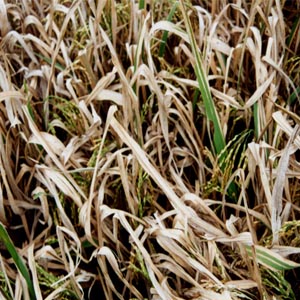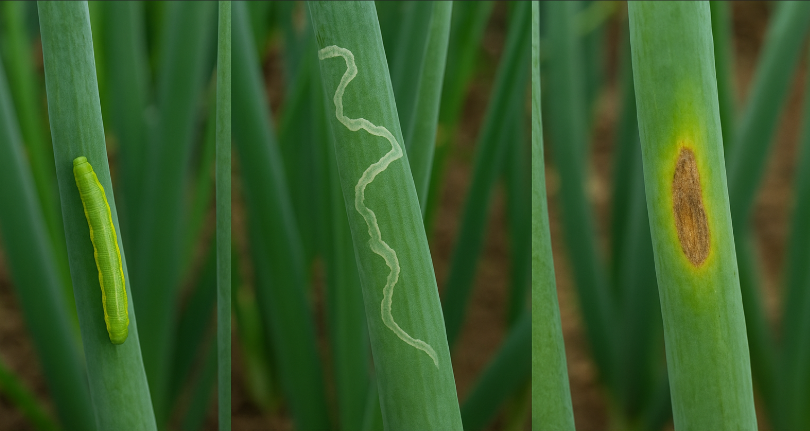
Bacterial diseases
Bacterial diseases of plants are an important and common group of diseases in agriculture. These diseases often cause serious damage to plants, affecting the yield and quality of products. Bacteria are the main cause of many diseases in plants, and they are often spread by water, wind, farming tools and insects. To protect crops, growers need to recognize the types of diseases caused by bacteria, as well as measures to prevent and control them.
Below are common diseases caused by bacteria and effective ways to prevent them:
1. Bacterial wilt

Cause
- Caused by the bacteria Ralstonia solanacearum. This bacterium often enters through wounds in the roots or through the plant's water-conducting system, causing serious damage to crops such as tomatoes, peppers, potatoes, eggplants, beans, and cucumbers.
Symptoms
- Leaf wilting: The diseased plant wilts suddenly during the day, the leaves may recover in the evening but then wilt completely.
- Root rot: The roots may turn dark brown and break easily..
- Vessels are cloudy: If the stem or roots are cut, the vessels may be discolored and have mucus flowing out.
Prevention
- Use disease-resistant varieties: Choose varieties that are resistant to bacterial wilt.
- Crop rotation: Rotate with crops that are not hosts to the bacteria, such as rice, corn, and beans to reduce the density of bacteria in the soil.
- Soil and seedling treatment: Use lime powder to improve the soil and check that the seedlings are not infected.
- Spraying biological pesticides: Use biological pesticides containing Bacillus subtilis or biological preparations to inhibit pathogenic bacteria.
2. Rice leaf blight

Causes
- Caused by the bacteria Xanthomonas oryzae pv. oryzae, which is spread by rainwater and wind. The disease often breaks out during the rainy season, when humid conditions are favorable for the growth of bacteria.
Symptoms
- Leaf lesions: Light brown or silvery white lesions appear on rice leaves. These lesions can spread and connect, causing the leaves to turn silver and the plant to fall easily.
- Wilting: When the disease is severe, the rice leaves wilt and die from the leaf tip to the base.
Prevention
- Use disease-resistant varieties: Plant rice varieties resistant to leaf blight.
- Manage irrigation water: Limit standing water on the field surface, especially during the rainy season.
- Balanced fertilization: Avoid applying too much nitrogen to help the plant grow healthily and increase resistance.
- Preventive spraying: Use drugs containing Streptomycin or Kasugamycin.
3. Soft rot

Causes
- Caused by the bacteria Erwinia carotovora. Soft rot commonly occurs in plants such as potatoes, tomatoes, vegetables, onions, garlic and some fruit trees such as watermelon and cucumber.
Symptoms
- Soft rot of plant tissue: Diseased parts become soft, turn brown and have an unpleasant odor.
- Yellow and falling leaves: As the disease progresses, the leaves may turn yellow, wilt and fall prematurely.
Prevention
- Keep the field clean: Collect and destroy diseased plant residues after harvest to eliminate pathogens.
- Control humidity: Limit over-watering or maintain high humidity in the stem parts near the base.
- Spray pesticides: Use biological pesticides containing Bacillus subtilis bacteria to control bacteria that cause soft rot.
4. Bacterial leaf spot

Causes
- Caused by Xanthomonas spp. or Pseudomonas spp. bacteria, the disease often attacks solanaceous plants (tomatoes, peppers) and leafy vegetables (lettuce, cabbage).
Symptoms
- Brown or black spots on leaves: Small, round brown or black spots appear on leaves and spread, causing leaves to wilt and fall off.
- Leaf wilt: The spots can cause leaves to wilt from the edges inward, leading to wilting and death of the plant.
Prevention
- Crop rotation: Avoid planting plants that are susceptible to bacterial leaf spot.
- Regular pruning: Remove and destroy infected leaves to limit the spread.
- Spraying with insecticides: Use Copper oxychloride or Streptomycin to control the disease.
5. Citrus greening

Causes
- Caused by the bacteria Candidatus Liberibacter and transmitted by the insect Diaphorina citri. The disease affects many citrus trees such as oranges, tangerines, and grapefruits, and severely reduces yields.
Symptoms
- Yellow leaves, green veins: The typical symptom is that the leaves turn yellow, but the veins remain green.
- Small and deformed fruit: Fruit on infected trees is often small, deformed, and dry inside.
- Stunted and dying plants: The disease slows plant growth and can kill plants after a few years if not treated.
Prevention
- Control of whitefly: Spray insecticides regularly and use yellow sticky traps to attract and kill whitefly.
- Plant resistant varieties: Use resistant or disease-resistant varieties.
- Remove infected plants: Uproot and destroy diseased plants to avoid spreading to healthy plants.
6. Bacterial leaf blight on vegetables (Brood blight)

Cause
- Caused by the bacteria Xanthomonas campestris, commonly found in cruciferous plants, lettuce, cabbage and leafy vegetables.
Symptoms
- Leaf burn at the leaf edge: Brown burn marks appear on the edges of the leaves, gradually spreading and causing leaf burn from the edge inward.
- Yellow and wilted leaves: When the disease is severe, the leaves turn yellow, wilt and fall off early, affecting the quality of vegetables.
Prevention
- Keep the garden clean: Collect and destroy diseased leaves to limit the source of disease.
- Balanced fertilization: Fertilize sufficiently and in balance to keep plants healthy and increase resistance.
- Spraying pesticides to prevent bacteria: Use bactericides such as Streptomycin or biological products containing Bacillus subtilis bacteria.
Conclusion

Diseases caused by bacteria can cause serious damage to crops if not controlled promptly. To prevent them effectively, growers need to apply comprehensive management measures, including:
- Use disease-resistant varieties.
- Implement field sanitation and crop rotation.
- Manage soil moisture, avoid waterlogging.
- Use pesticides to prevent bacteria according to instructions.
Prevention and control of bacterial diseases help plants stay healthy, increase productivity and product quality, and contribute to environmental protection.
Bình luận
Những bình luận mới nhất



